Shenzhen Mindray Bio-Medical Electronics Bundle
Who Really Owns Shenzhen Mindray Bio-Medical?
Unraveling the ownership structure of Shenzhen Mindray Bio-Medical Electronics SWOT Analysis is essential for investors and strategists alike. Mindray's journey from the New York Stock Exchange to the Shenzhen Stock Exchange in 2018 marked a significant shift in its ownership landscape. Understanding the key players behind this medical device giant provides crucial insights into its future trajectory and potential investment opportunities.
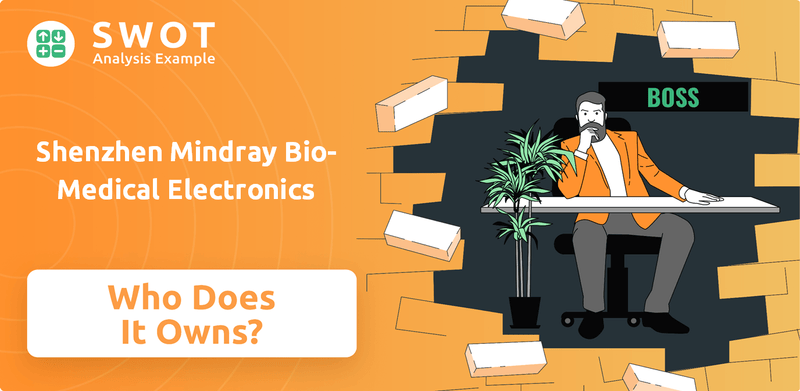
This exploration of Mindray ownership will examine the evolution of the Mindray company, from its founding to the influence of major stakeholders. We'll analyze the impact of its re-listing on the Shenzhen Stock Exchange and its implications for the company's governance. This analysis will also address questions like "Who founded Shenzhen Mindray Bio-Medical?" and "Is Mindray a public company?" to provide a comprehensive understanding of this leading medical technology firm, including its Mindray headquarters and the Mindray stock.
Who Founded Shenzhen Mindray Bio-Medical Electronics?
The story of Shenzhen Mindray Bio-Medical Electronics Company, now a global player in the medical device industry, began in 1991. It was founded in the Financial Center on Taizi Road, Shekou, Nanshan District, Shenzhen, China, by a team of seven former employees from Anke.
The founders shared a common goal: to develop high-quality, affordable medical equipment within China, reducing reliance on imports and improving healthcare accessibility. Key figures in the company's early days included Li Xiting, Xu Hang, and Cheng Minghe, whose combined vision shaped the company's initial direction.
Understanding the early ownership structure of Mindray is crucial to grasping its journey from a startup to a major corporation. While the exact initial equity distribution among the seven founders isn't publicly available, early investment rounds provide valuable insights into the company's financial backing and growth trajectory.
In 1995, Mindray secured its first investment round, receiving $2 million from Walden International. This initial funding was critical for the company's early operations and product development.
Following the first round, Mindray attracted an additional $6 million from Walden International and other venture capital funds. These investments fueled further expansion and innovation.
In 2003, ShenZhen GTJA Investment Group participated in a Series A funding round, providing additional capital for Mindray's growth. The amount of this investment was not disclosed.
Goldman Sachs was among the early institutional investors in Mindray, demonstrating confidence in the company's potential. These early backers played a crucial role in providing the capital necessary for Mindray's initial growth.
These early investments supported the development of key products, including China's first self-developed multi-parameter patient monitor and hematology analyzer. These innovations helped establish Mindray's presence in the market.
These early investments supported the development of key products, including China's first self-developed multi-parameter patient monitor and hematology analyzer. These innovations helped establish Mindray's presence in the market.
The early investments and the vision of the founders were pivotal in shaping the trajectory of the Mindray company. These early investments provided the necessary capital for product development, market entry, and expansion, laying the groundwork for Mindray's future success. For more insights into the company's history, you can explore the details in this article about Shenzhen Mindray Bio-Medical Electronics. The company's ability to secure funding from both domestic and international sources highlights the early recognition of its potential and the importance of strategic partnerships in its initial growth phase.
Shenzhen Mindray Bio-Medical Electronics SWOT Analysis
- Complete SWOT Breakdown
- Fully Customizable
- Editable in Excel & Word
- Professional Formatting
- Investor-Ready Format
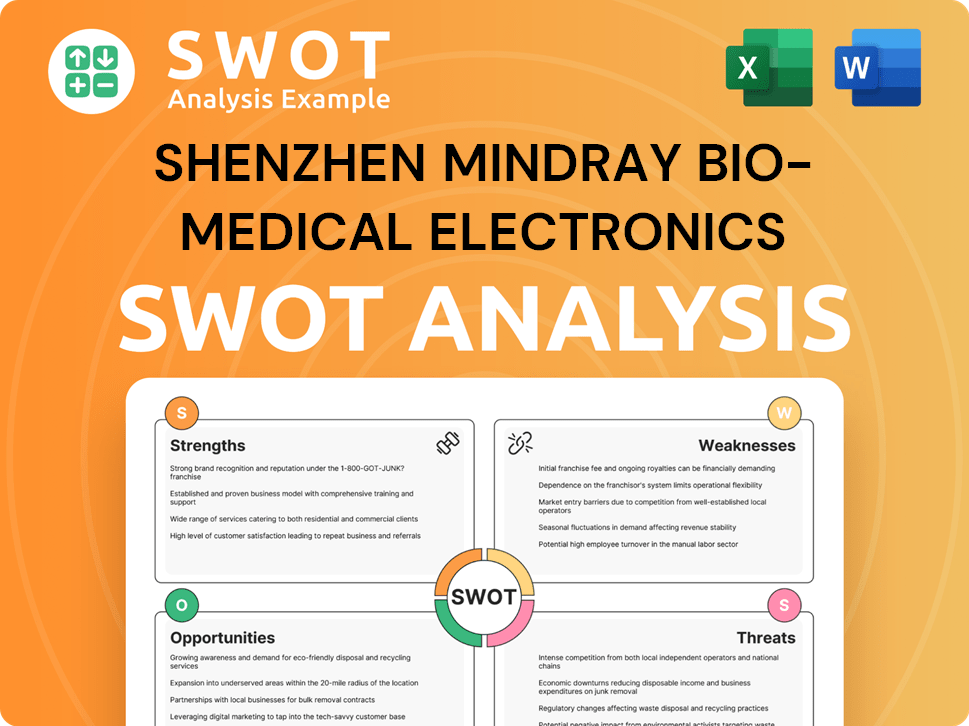
How Has Shenzhen Mindray Bio-Medical Electronics’s Ownership Changed Over Time?
The ownership structure of Shenzhen Mindray Bio-Medical Electronics has seen significant shifts since its inception. Initially listed on the New York Stock Exchange (NYSE) in September 2006, becoming the first Chinese medical device company to do so, the company's journey involved an initial public offering (IPO) and a secondary offering. The company's ownership structure was further reshaped when it delisted from the U.S. stock market in March 2016, following a privatization deal driven by key executives. This move led to a relisting on the Shenzhen Stock Exchange in October 2018.
The initial IPO in 2006 involved the sale of 23,000,000 American Depositary Shares (ADSs). A secondary offering followed in February 2007, allowing pre-IPO investors to capitalize on their gains. The privatization deal in 2016, initiated by top executives, marked a pivotal change in the company's ownership landscape. Following the delisting, the company re-listed on the Growth Enterprise Market of the Shenzhen Stock Exchange in October 2018.
| Event | Date | Impact on Ownership |
|---|---|---|
| Initial Public Offering (IPO) | September 2006 | Listed on NYSE; sale of 23,000,000 ADSs. |
| Secondary Offering | February 2007 | Allowed pre-IPO investors to sell shares. |
| Privatization and Delisting | March 2016 | Delisted from NYSE; driven by executives. |
| Relisting | October 2018 | Re-listed on the Shenzhen Stock Exchange. |
As of March 8, 2024, individual insiders, primarily the founders, held a significant majority of Shenzhen Mindray Bio-Medical Electronics, with 56% ownership. Li Xiting, the largest shareholder, held 27% of the shares, while the second-largest shareholder held about 25%. Institutional investors held approximately 18% to 20% of the company's stock. By April 9, 2025, Shenzhen Mindray Bio-Medical Electronics Co., Ltd. had 223 institutional owners and shareholders holding a total of 26,232,473 shares. Major institutional shareholders included Harding Loevner International Equity Portfolio Institutional (HLMIX), Fidelity Emerging Markets Fund (FEMKX), and JPMorgan Emerging Markets Equity Fund Class I (JEMSX). The general public owned about 21% to 22% of the company. To understand more about the company's journey, you can read the Brief History of Shenzhen Mindray Bio-Medical Electronics.
Key takeaways from the ownership structure of Shenzhen Mindray Bio-Medical.
- Founders hold a significant majority of shares.
- Institutional investors hold a substantial portion of the stock.
- The company has shifted its listing location over time.
- The largest shareholder, Li Xiting, holds 27% of shares.
Shenzhen Mindray Bio-Medical Electronics PESTLE Analysis
- Covers All 6 PESTLE Categories
- No Research Needed – Save Hours of Work
- Built by Experts, Trusted by Consultants
- Instant Download, Ready to Use
- 100% Editable, Fully Customizable
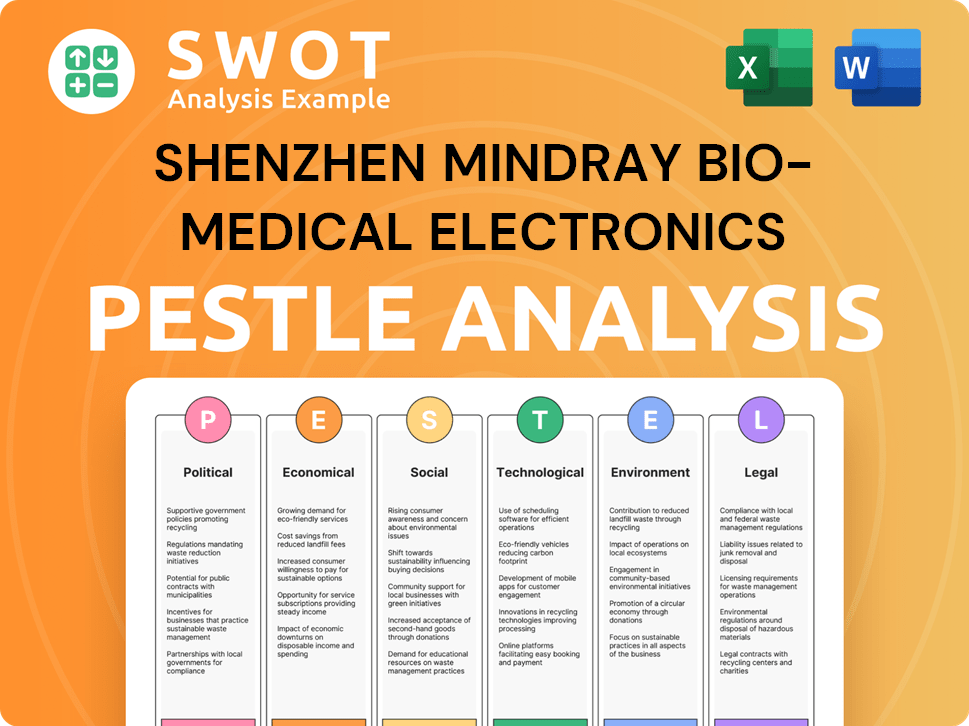
Who Sits on Shenzhen Mindray Bio-Medical Electronics’s Board?
The current board of directors of Shenzhen Mindray Bio-Medical Electronics Co., Ltd. significantly influences the company's strategic direction and operational oversight. As of June 2025, the board comprises a blend of executive and independent directors, ensuring a balance of operational expertise and external perspectives. Key figures include Li Xiting as Chairman, Xu Hang, and Cheng Minghe as Vice Chairman, along with Wu Hao, the President, and Guo Yanmei, an Executive Vice President. Independent directors such as Liang Huming, Zhou Xianyi, Hu Shanrong, Gao Shengping, Xu Jing, and Kong Yu also contribute to the board's diverse viewpoints.
This composition reflects a commitment to both internal leadership and external governance. The presence of independent directors is crucial for maintaining transparency and ensuring accountability in the company's decision-making processes. This structure is designed to support sustainable growth and maintain stakeholder confidence, which is vital for a company like Shenzhen Mindray, especially considering its global market presence and the need to navigate complex regulatory environments.
| Board Member | Title | Role |
|---|---|---|
| Li Xiting | Chairman | Non-Independent Director |
| Xu Hang | - | Non-Independent Director |
| Cheng Minghe | Vice Chairman | Non-Independent Director |
| Wu Hao | President | Non-Independent Director |
| Guo Yanmei | Executive Vice President | Non-Independent Director |
| Liang Huming | - | Independent Director |
| Zhou Xianyi | - | Independent Director |
| Hu Shanrong | - | Independent Director |
| Gao Shengping | - | Independent Director |
| Xu Jing | - | Independent Director |
| Kong Yu | - | Independent Director |
The voting structure of Shenzhen Mindray Bio-Medical, particularly during its NYSE listing, involved a dual-class share system. This system granted significant control to the founders and key executives. The 2016 privatization further highlighted the influence of major shareholders. For more insights into the company's financial operations, you can explore the Revenue Streams & Business Model of Shenzhen Mindray Bio-Medical Electronics. The current voting structure on the Shenzhen Stock Exchange might differ, but the substantial insider ownership, with Li Xiting holding approximately 27% and the top two shareholders controlling 52%, indicates that influential individuals continue to shape the company's strategic direction.
The board of directors at Shenzhen Mindray Bio-Medical includes a mix of executive and independent directors.
- Li Xiting serves as Chairman.
- The company's voting structure grants significant influence to key shareholders.
- The current structure supports both internal leadership and external governance.
- Independent directors contribute to transparency and accountability.
Shenzhen Mindray Bio-Medical Electronics Business Model Canvas
- Complete 9-Block Business Model Canvas
- Effortlessly Communicate Your Business Strategy
- Investor-Ready BMC Format
- 100% Editable and Customizable
- Clear and Structured Layout
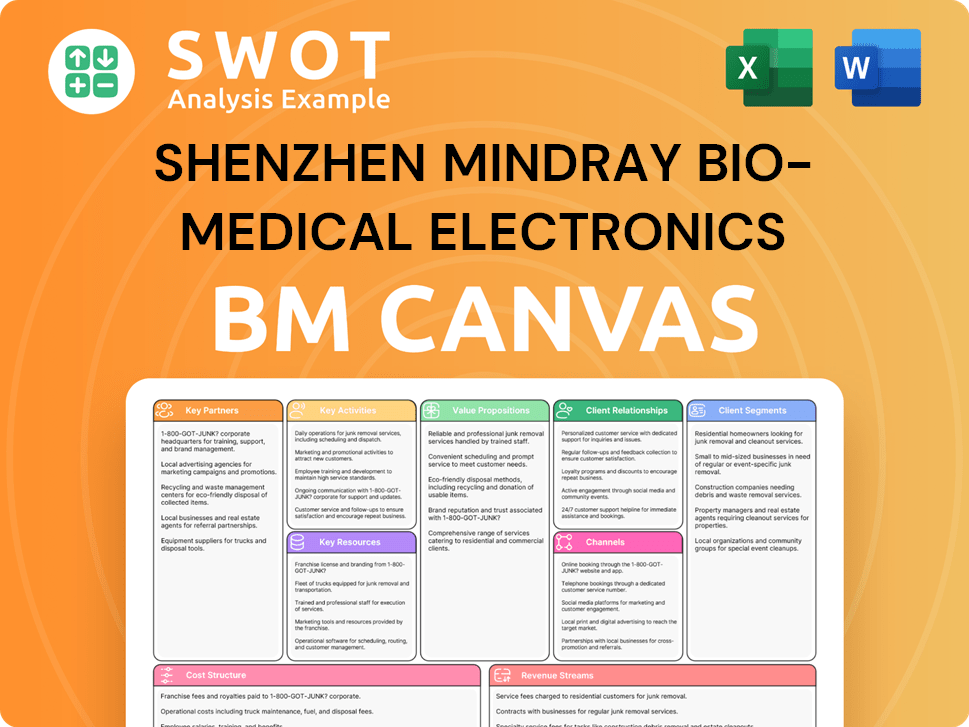
What Recent Changes Have Shaped Shenzhen Mindray Bio-Medical Electronics’s Ownership Landscape?
In the past few years, Shenzhen Mindray Bio-Medical Electronics has shown robust financial performance. For the first half of 2024, the company's revenue reached RMB 20.5 billion, an 11.1% increase year-on-year. The net profit attributable to shareholders for 2024 was CNY 11.67 billion. This financial strength is a key factor influencing the company's ownership profile, as it demonstrates its ability to generate consistent returns and attract investor interest.
Mindray's strategic initiatives, including acquisitions and technology integrations, also impact its ownership structure. The acquisition of a 75% stake in DiaSys in 2022 and plans to control APT Medical highlight the company's growth strategy. Mindray's focus on Intelli-Digital Transformation, integrating AI, further strengthens its market position. These moves can influence investor confidence and potentially lead to shifts in the Mindray ownership landscape.
| Financial Metric | 2023 | 2024 |
|---|---|---|
| Total Revenue (¥ Billion) | ¥409.85 | ¥437.78 |
| Net Profit (CNY Billion) | N/A | CNY 11.67 |
| Revenue Growth (Year-on-Year) | N/A | 11.1% (H1 2024) |
The management team has become more professionalized, with Shentu Xianzhong leading operations since 2018. The founder's family maintains a significant alignment with approximately 18% ownership. Mindray has also updated its internal governance systems, including its 'Foreign Investment Decision-Making System' and 'Internal Audit System'. The company's commitment to long-term rewards for investors and sharing the benefits of its growth was stated upon its re-listing in 2018, indicating a focus on sustained value creation for its shareholders.
The founder's family holds around 18% of Mindray's ownership. This significant stake aligns their interests with other shareholders.
Mindray acquired a 75% stake in DiaSys in 2022. The company is also planning to control APT Medical.
Mindray's revenue for the first half of 2024 was RMB 20.5 billion. The net profit attributable to shareholders for 2024 was CNY 11.67 billion.
Mindray is focusing on Intelli-Digital Transformation, integrating AI. This includes AI-powered blood testing equipment and the M Connect service.
Shenzhen Mindray Bio-Medical Electronics Porter's Five Forces Analysis
- Covers All 5 Competitive Forces in Detail
- Structured for Consultants, Students, and Founders
- 100% Editable in Microsoft Word & Excel
- Instant Digital Download – Use Immediately
- Compatible with Mac & PC – Fully Unlocked
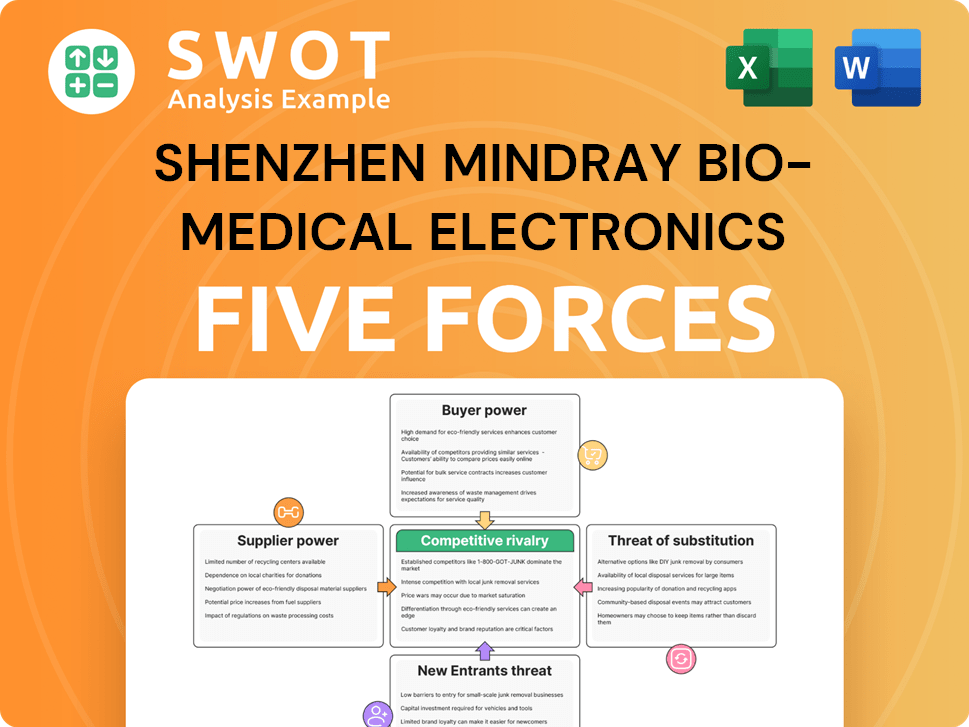
Related Blogs
- What are Mission Vision & Core Values of Shenzhen Mindray Bio-Medical Electronics Company?
- What is Competitive Landscape of Shenzhen Mindray Bio-Medical Electronics Company?
- What is Growth Strategy and Future Prospects of Shenzhen Mindray Bio-Medical Electronics Company?
- How Does Shenzhen Mindray Bio-Medical Electronics Company Work?
- What is Sales and Marketing Strategy of Shenzhen Mindray Bio-Medical Electronics Company?
- What is Brief History of Shenzhen Mindray Bio-Medical Electronics Company?
- What is Customer Demographics and Target Market of Shenzhen Mindray Bio-Medical Electronics Company?
Disclaimer
All information, articles, and product details provided on this website are for general informational and educational purposes only. We do not claim any ownership over, nor do we intend to infringe upon, any trademarks, copyrights, logos, brand names, or other intellectual property mentioned or depicted on this site. Such intellectual property remains the property of its respective owners, and any references here are made solely for identification or informational purposes, without implying any affiliation, endorsement, or partnership.
We make no representations or warranties, express or implied, regarding the accuracy, completeness, or suitability of any content or products presented. Nothing on this website should be construed as legal, tax, investment, financial, medical, or other professional advice. In addition, no part of this site—including articles or product references—constitutes a solicitation, recommendation, endorsement, advertisement, or offer to buy or sell any securities, franchises, or other financial instruments, particularly in jurisdictions where such activity would be unlawful.
All content is of a general nature and may not address the specific circumstances of any individual or entity. It is not a substitute for professional advice or services. Any actions you take based on the information provided here are strictly at your own risk. You accept full responsibility for any decisions or outcomes arising from your use of this website and agree to release us from any liability in connection with your use of, or reliance upon, the content or products found herein.